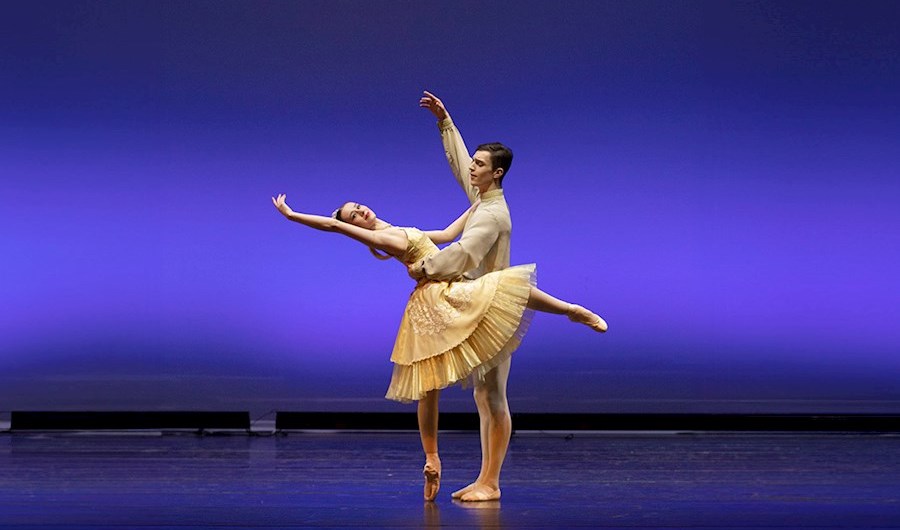The Concourse Theatre, Sydney.
September 2023.
The programme, filmed at The Concourse Chatswood and streamed by the Australian Digital Concert Hall, opened with Degas Dances choreographed by Paul Knobloch, a tribute to Degas and dance history. The enchanting elegant set included three large windows, plus a dancer replicating Degas’ Little Dancer standing on a plinth, two barres and a large standing ‘painting’. In some ways, Degas Dances is dreamlike as we jump between ballet classes of today, with a teacher, then we jump to Degas’ time, with the dancers coming through the large painting and one of the young male dancers from our time falling in love with the Degas statue with some glorious snippets of pas de deux.
The teacher has a lot of strong demanding pointe work and gives her class white forms (drawing boards?) which eventually they briefly hold up, revealing their work to be an illustration of the Little Dancer on the plinth. There are precise lines of choreography for the women and a fast wheeling solo for one of the men. The Degas-era costumes are the white tutus and black neck ribbon the female dancers wore with the men in grey and white with a black scarf. The work alludes to Le Conservatoire. There are high, soft jumps required for the men of the Degas-era almost échappés to second position and again lines of choreography for the women. Suddenly, a tableaux pose and those of the Degas era vanish back through the painting. But the Little Dancer remains, back on her plinth; everyone from ‘today’ then leaves.
Next was Chairman Dances with choreography by Tim Harbour. This began with the ensemble standing with their arms up and the young women wearing leotards with short skirts and diagonal stripes on their bodices. The men were in purple with lines on their outfits. Choreographically, it was challenging, very fast, demanding long stretched arms at times and difficult lifts as well as at times sculptural lines, dividing into halves with circles of light and concluding with the ensemble kneeling then a frozen tableaux.
Then we saw the Raymonda Act III Grand Pas, restaged after Marius Petipa – a return to exacting classical ballet roots. A blue wash lit the back cyclorama. The young women were in knee-length tutus with aprons, the men in white tights and long-sleeved tops. Technically, the dancing was splendid, with creamy control, a long stretched ‘line’ at times and some fast, fleet footwork, a delightful tilt into an arabesque penché by the young women en pointe and some testing lifts. The solos were terrific – there was a delightful very fast travelling solo for a Macy Trethewey en pointe, with creamy jumps and fast fleet footwork, then a trio for women (Tully Cook, Sophie Donald, Kit Thompson), followed by a dazzling pas de quatre by Thomas Bodington, Corey Gavan, Ned Manning-Lourey and Charlton Tough displaying their impressive jumps and turns. Nicoletta Moshidis then performed the famous set piece handclap solo, with a long luscious ‘line’, strong pointework and fast, furious turns. This was followed by a polished solo by Jeremy Hargreaves, and the piece concluded with a galloping finale.
After interval, we saw (or rather tried to see, the lighting was so dark it was almost impossible to distinguish) Techno Requiem choreographed by Lucas Jervies with a pounding soundtrack by Adam Ster. I could discern swirling lines, rippling, undulating arms (and the lines of the arms were important, too), spinning or rolling floorwork, and unusual wrap around lifts. From what I could make out, the work concluded with a fast flowing, sinuous, sculptural pas de deux.
Then came the rather severe, cleanly abstract Nexus with choreography by Stephen Baynes opening with the dancers silhouetted against a blue cyc background. The young women were in blue leotards with white tights, the men in black leotards. Again, the choreography required the dancers in measured lines with the look of the ‘line’ of arms being significant. There was a pas de six for more of the young women in blue leotards with short skirts and a most exciting texture to their costumes. We then returned to the ensemble, the choreography showing off the rigorous partnering required, kneeling turns, high lifts and some soft creamy folding arms for the women. The work concluded with a jogging run.
The last work was Glorious Monsters choreographed by Simon Dow, which began angrily with the ensemble in black shorts and white tops shaking their fists. There were tumultuous rolls, bent over jumps, sinuous writhing, marching and saluting, thigh slapping, turned in jumps, high kicks, angular arms, running in a circle, and at various points, there was a lineup with ‘Chinese Whispers’, laughs, screams and other vocalisations. The works was a strange mix of ballet and contemporary styles.
This showcase was a quite mixed performance of various dance styles.
By Lynne Lancaster of Dance Informa.

















